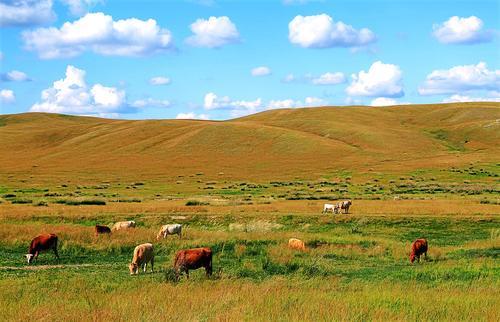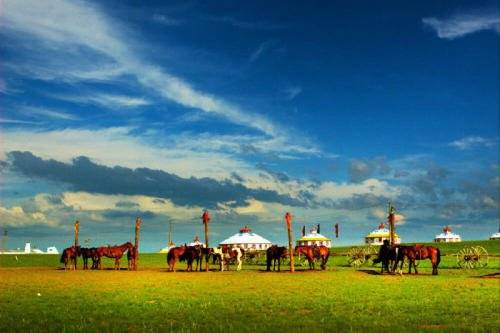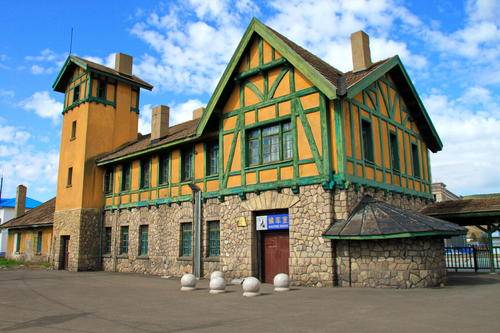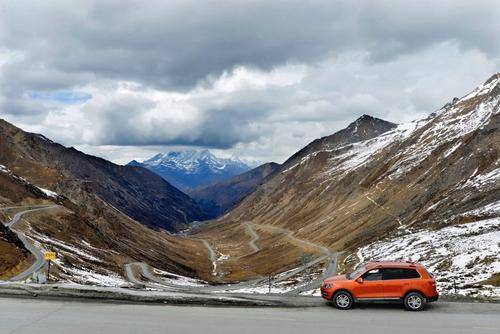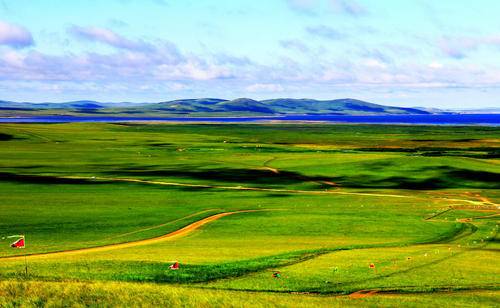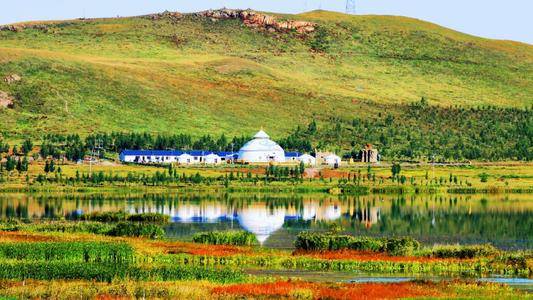Baiyin Chagan Aobao
In Baiyin Chagan, there is an Aobao made of bricks and stones. Every year on the thirteenth day of the fifth lunar month, locals from nearby come here to participate in the Aobao worship ceremony. Besides praying for blessings, there are also traditional horse racing and wrestling competitions. If you haven't had enough of the Ujumqin Grassland scenery in West Ujimqin Banner, you can continue to feast your eyes in East Ujimqin Banner.
Uzhumuqin Grassland
Uzhumuqin Grassland spans across East and West Uzhumuqin Banners. The West Uzhumuqin Banner is characterized by the sea of wolf poison flowers, while the East Uzhumuqin Banner gained fame through the novel 'Wolf Totem'. The novel 'Wolf Totem' was conceived in Mandu Baolige Town in the East Uzhumuqin Banner. Mandu Baolige Town has a significantly higher number of cattle, horses, and wolves compared to other grasslands. The author of 'Wolf Totem', Jiang Rong, was inspired while herding during his time in this area, which led to the creation of his masterpiece. Additionally, the grassland in the East Uzhumuqin Banner experiences rapidly changing weather, with thunderstorms and lightning coming and going quickly, and the sunrises and sunsets are spectacular.
Aershan
Aershan is a volcanic group located in the upper reaches of the Halaha River in the central part of the Greater Khingan Range. It boasts a diverse natural ecosystem and precious hot spring resources, making it a tourist destination where visitors can enjoy both volcanic landscapes and the nourishment of hot springs.
Provincial Highway 303
The once asphalt road is now full of potholes, which greatly tests the performance of vehicles. It is a highly challenging road. With a total length of 300 kilometers, it is necessary to refuel and stay overnight after reaching Mandubaolige before continuing the journey.
Ulagai Gobi
Located within the basin near Dongwu Banner, the Ulagai Gobi. The once azure lake has now turned into a dried-up saline-alkali flat, only reuniting into a lake during the rainy season due to accumulated water, thus earning the nickname 'the disappearing lake.' Along the road through the Gobi, one can often see wet meadows where grass and water coexist, known as the Ulagai Wetland. The Ulagai Wetland covers a large area. Today, the scenery of the Ulagai Gobi has a sharp beauty, but it also evokes a sense of melancholy.
Ulagai Grassland
Ulagai Grassland is the true setting of the story in the novel 'Wolf Totem'. It is named after the Ulagai River, with 'Ulagai' meaning 'cradle' in Mongolian. Ulagai is vast and rich in resources, with fertile land that supports not only cattle and sheep but also migrating wolf packs in winter. Additionally, Ulagai Grassland is an ancient battlefield where Genghis Khan fought to unify Mongolia.
Hesge Nuur Wetland
Hesge Nuur Wetland is located in the northeast of Hesge Ula Ranch in Ulagai, covering a vast area of 29,769 hectares. The region is rich in marsh wetland resources, with numerous springs scattered throughout. The vegetation is lush, and many rare bird species inhabit the area. Every spring and autumn, Hesge Nuur Wetland becomes a stopover point for migratory birds.
Wild Wolf Valley
If you want to see the elegance of wolves, Wild Wolf Valley in the Ulagai Grassland is the best place to go. Wild Wolf Valley is a tourism spot that emphasizes natural ecology and is also the main filming location for the movie 'Wolf Totem'. The scenic area not only has a wolf domestication base and a wildlife rescue station but also designates 200 acres as a wild breeding area where dozens of wild prairie wolves live and reproduce.
Gulaobsaikhan Aobao
Here lie three Aobao mountains, hence the name Gulaobsaikhan, which means 'Three Beautiful Mountains' in Mongolian. The lunar May is the most bustling time for Gulaobsaikhan, attracting many herders from afar who bring offerings such as milk, wine, and beef and mutton to worship and pray. After the worship ceremony, grand traditional Mongolian sports and dance banquets are held.
